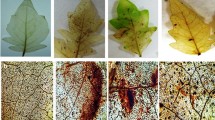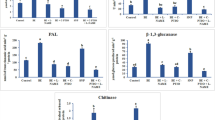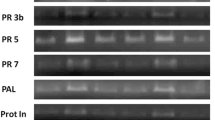Abstract
Key message
Foliar application of SA cross-talks and induce endogenous nitric oxide and reactive oxygen species to improve innate immunity and vigor of tomato plant against Fusarium oxysporum stress.
Abstract
The present investigation was aimed to demonstrate the efficacy of salicylic acid (SA), as a powerful elicitor or plant growth regulator (PGR) and its cross-talk with nitric oxide (NO) in tomato against the biotic stress caused by wilt pathogen, Fusarium oxysporum f. sp. lycopersici. Different defense-related enzymes and gene expression, phenol, flavonoid, and phenolic acid content along with NO generation and other physiological characters have been estimated after foliar application of SA. Total chlorophyll content was steadily maintained and the amount of death of cells was negligible after 72 h of SA treatment. Significant reduction of disease incidence was also recorded in SA treated sets. Simultaneously, NO generation was drastically improved at this stage, which has been justified by both spectrophotometrically and microscopically. A direct correlation between reactive oxygen species (ROS) generation and NO has been established. Production of defense enzymes, gene expressions, different phenolic acids was positively influenced by SA treatment. However, tomato plants treated with SA along with NO synthase (NOS) inhibitor or NO scavenger significantly reduce all those parameters tested. On the other hand, NO donor-treated plants showed the same inductive effect like SA. Furthermore, SA treated seeds of tomato also showed improved physiological parameters like higher seedling vigor index, shoot and root length, mean trichome density, etc. It is speculated that the cross-talk between SA and endogenous NO have tremendous ability to improve defense responses and growth of the tomato plant. It can be utilized in future sustainable agriculture for bimodal action.






Similar content being viewed by others
References
Acharya K, Chakraborty N, Dutta AK, Sarkar S, Acharya R (2011) Signaling role of nitric oxide in the induction of plant defense by exogenous application of abiotic inducers. Arch Phytopathol Plant Protect 44:1501–1511. https://doi.org/10.1080/03235408.2010.507943
Anand David AV, Arulmoli R, Parasuraman S (2016) Overviews of biological importance of quercetin: a bioactive flavonoid. Pharmacogn Rev 10:84–89. https://doi.org/10.4103/0973-7847.194044
Arnon DI (1949) Copper enzymes in isolated chloroplasts Polyphenoloxidase in Beta Vulgaris. Plant Physiol 24:1–15. https://doi.org/10.1104/pp.24.1.1
Baker CJ, Orlandi EW (1995) Active oxygen in plant pathogenesis. Phytopathol 33:299–321
Balasubramanian V, Vashisht D, Cletus J, Sakthivel N (2012) Plant β-1,3-glucanases: their biological functions and transgenic expression against phytopathogenic fungi. Biotechnol Lett 34:1983–1990
Bartha B, Kolbert Z, Erdei L (2005) Nitric oxide production induced by heavy metals in Brassica juncea L. Czern and Pisum sativum L. Acta Biol Szeged 49:9–12
Bethke PC, Libourel IGL, Aoyama N, Chung Y, Still DW, Jones RL (2007) The Arabiodopsis thaliana aleurone layer responds to nitric oxide, gibberellins and abscisic acid and is sufficient and necessary for seed dormancy. Plant Physiol 143:1173–1188. https://doi.org/10.1104/pp.106.093435
Boughton AJ, Hoover K, Felton GW (2005) Methyl jasmonate application induces increased densities of glandular trichomes on tomato, Lycopersicon esculentum. J Chem Ecol 31:2211–2216. https://doi.org/10.1007/s10886-005-6228-7
Boz H (2015) p-Coumaric acid in cereals: presence, antioxidant and antimicrobial effects. Int J Food Sci Tech 50(11):2323–2328. https://doi.org/10.1111/ijfs.12898
Bradford M (1976) A rapid and sensitive method for the quantitation of microgram quantities of protein utilizing the principle of protein dye binding. Anal Biochem 72:248–254. https://doi.org/10.1016/0003-2697(76)90527-3
Chakraborty N, Acharya K (2017) “NO way”! Says the plant to abiotic stress. Plant Gene 11:99–105. https://doi.org/10.1016/j.plgene.2017.05.001
Chakraborty N, Chandra S, Acharya K (2015) Sublethal heavy metal stress stimulates innate immunity in tomato. Scientific World J. https://doi.org/10.1155/2015/208649
Chakraborty N, Ghosh S, Chandra S, Sengupta S, Acharya K (2016) Abiotic elicitors mediated elicitation of innate immunity in tomato: an ex vivo comparison. Physiol Mol Biol Plants 22:307–320. https://doi.org/10.1007/s12298-016-0373-z
Chakraborty N, Chandra S, Acharya K (2017) Biochemical basis of improvement of defense in tomato plant against Fusarium wilt by CaCl2. Physiol Mol Biol Plants 23:581–596. https://doi.org/10.1007/s12298-017-0450-y
Chakraborty N, Mukherjee K, Sarkar A, Acharya K (2019) Interaction between bean and Colletotrichum gloeosporioides: understanding through a biochemical approach. Plants 8(9):345. https://doi.org/10.3390/plants8090345
Chakraborty N, Sarkar A, Acharya K (2020) Multifaceted Roles of Salicylic Acid and Jasmonic Acid in Plants against Abiotic Stresses. In: Protective chemical agents in the amelioration of plant abiotic stress. Wiley, UK, pp 374–388
Chandra S, Chakraborty N, Chakraborty A et al (2014) Induction of defence response against blister blight by calcium chloride in tea. Arch Phytopathol Plant Prot 47:2400–2409. https://doi.org/10.1080/03235408.2014.880555
Chandra S, Chakraborty N, Dasgupta A et al (2015) Chitosan nanoparticles: a positive modulator of innate immune responses in plants. Sci Rep 5:15195. https://doi.org/10.1038/srep15195
Dangol S, Chen Y, Hwang BK, Jwa N-S (2019) Iron- and reactive oxygen species-dependent ferroptotic cell death in rice-Magnaporthe oryzae interactions. Plant Cell 31:189–209. https://doi.org/10.1105/tpc.18.00535
Dempsey DA, Klessig DF (2017) How does the multifaceted plant hormone salicylic acid combat disease in plants and are similar mechanisms utilized in humans? BMC Biol 15:23
Dickerson DP, Pascholati SF, Hagerman AE, Nicholson BLG, RL, (1984) Phenylalanine ammonia-lyase and hydroxycinnamate: CoA ligase in maize mesocotyls inoculated with Helminthosporium maydis or Helminthosporium carbonum. Physiol Plant Pathol 25:111–123. https://doi.org/10.1016/0048-4059(84)90050-X
Dong J, Wan G, Liang Z (2010) Accumulation of salicylic acid-induced phenolic compounds and raised activities of secondary metabolic and antioxidative enzymes in Salvia miltiorrhiza cell culture. J Biotechnol 148:99–104
Fancy NN, Bahlmann AK, Loake GJ (2017) Nitric oxide function in plant abiotic stress. Plant Cell Environ 40:462–472
Glazebrook J (2005) Contrasting mechanisms of defense against biotrophic and necrotrophic pathogens. Annu Rev Phytopathol 43:205–227
Hasanuzzaman M, Nahar K, Alam MM, Fujita M (2012) Exogenous nitric oxide alleviates high temperature induced oxidative stress in wheat (Triticum aestivum L.) seedlings by modulating the antioxidant defense and glyoxalase system. Aust J Crop Sci 6:1314
Hemeda HM, Klein BP (1990) Effects of naturally occurring antioxidants on peroxidase activity of vegetable extracts. J Food Sci 55:184–185. https://doi.org/10.1111/j.1365-2621.1990.tb06048.x
Jendoubi W, Harbaoui K, Hamada W (2017) Salicylic acidinduced resistance against Fusarium oxysporum f. s.p radicis lycopercisi in hydroponic grown tomato plants. J New Sci Agric Biotechnol 21:985–995
Jia XL, Wang GL, Xiong F, Yu XR, Xu ZS, Wang F (2015) Xiong AS (2015) De novo assembly, transcriptome characterization, lignin accumulation, and anatomic characteristics: novel insights into lignin biosynthesis during celery leaf development. Sci Rep 5:8259
Kazemi M (2013) Foliar application of salicylic acid and calcium on yield, yield component and chemical properties of strawberry. Bull Environ Pharmacol Life Sci 2:19–23
Khatua S, Dutta AK, Acharya K (2015) Prospecting Russula senecis: a delicacy among the tribes of West Bengal. PeerJ 3:e810. https://doi.org/10.7717/peerj.810
Kim YH, Hamayun M, Khan AL, In Na C, Kang SM, Han HH, Lee I-J (2009) Exogenous application of plant growth regulators increased the total flavonoid content in Taraxacum officinale Wigg. Afr J Biotechnol 8: 5727–5732. http://www.academicjournals.org/AJB
Klessig DF, Choi HW, Dempsey DA (2018) Systemic acquired resistance and salicylic acid: past, present, and future. Mol Plant-Microbe Interact 31:871–888
Koch E, Slusarenko A (1990) Arabidopsis is susceptible to infection by a downy mildew fungus. Plant Cell 2:437–445
Koo YM, Heo AY, Choi HW (2020) Salicylic acid as a safe plant protector and growth regulator. Plant Pathol J 36:1–10. https://doi.org/10.5423/PPJ.RW.12.2019.0295
Kumar K, Khan P (1982) Peroxidase and polyphenol oxidase in excised ragi (Eleusine corocana cv PR 202) leaves during senescence. Indian J Exp Biol 20:412–416
Lamb C, Dixon RA (1997) The oxidative burst in plant disease resistance. Annu Rev Plant Physiol Plant Mol Biol 48:251–275
Le Thanh T, Thumanu K, Wongkaew S, Boonkerd N, Teaumroong N, Phansak P, Buensanteai N (2017) Salicylic acid-induced accumulation of biochemical components associated with resistance against Xanthomonas oryzae pv. oryzae in rice. J Plant Interact 12:108–120
Mandal S, Mallick N, Mitra A (2009) Salicylic acid-induced resistance to Fusarium oxysporum f. sp. lycopersici in tomato. Plant Physiol Biochem 47:642–649. https://doi.org/10.1016/j.plaphy.2009.03.001
Manzo D, Ferriello F, Puopolo G, Zoina A, D’Esposito D, Tardella L, Ferrarini A, Ercolano MR (2016) Fusarium oxysporum f sp radicis-lycopersici induces distinct transcriptome reprogramming in resistant and susceptible isogenic tomato lines. BMC Plant Biol 16(1):53. https://doi.org/10.1186/s12870-016-0740-5
Medeiros FCL, Resende MLV, Medeiros FHV et al (2009) Defense gene expression induced by a coffee-leaf extract formulation in tomato. Physiol Mol Plant Pathol 74:175–183. https://doi.org/10.1016/j.pmpp.2009.11.004
Nahar K, Ullah SM (2012) Morphological and physiological characters of tomato (Lycopersicon esculentum Mill) cultivars under water stress. Bangladesh J Agric Res 37:355–360
Ngullie CR, Tank RV, Bhanderi DR (2014) Effect of salicylic acid and humic acid on flowering, fruiting, yield and quality of mango (Mangifera indica L.) cv. KESAR Adv Res J Crop Improv 5:136–139
Nicholson RL, Hammerschmidt R (1992) Phenolic compounds and their role in disease resistance. Annu Rev Phytopathol 30:369–389
Niu L, Liao W (2016) Hydrogen peroxide signaling in plant development and abiotic responses: crosstalk with nitric oxide and calcium. Front Plant Sci 7:230
Nürnberger T, Brunner F, Kemmerling B, Piater L (2004) Innate immunity in plants and animals: striking similarities and obvious differences. Immunol Rev 198:249–266
Pan SQ, Ye XS, Kuć J (1991) Association of β-1,3-glucanase activity and isoform pattern with systemic resistance to blue mould in tobacco induced by stem injection with Peronospora tabacina or leaf inoculation with tobacco mosaic virus. Physiol Mol Plant Pathol 39:25–39. https://doi.org/10.1016/0885-5765(91)90029-H
Parmar P, Subramanian R (2012) Biochemical alteration induced in tomato (Lycopersicum esculentum) in Response to Fusarium oxysporum f. sp. lycopersici. Afr J Basic Appl Sci 4:186–191. https://doi.org/10.5829/idosi.ajbas.2012.4.5.1114
Peng H, Yang T, Jurick WM (2014) Calmodulin gene expression in response to mechanical wounding and Botrytis cinerea infection in tomato fruit. Plants 3:427–441. https://doi.org/10.3390/plants3030427
Pérez-Llorca M, Muñoz P, Müller M, Munné-Bosch S (2019) Biosynthesis, metabolism and function of auxin, salicylic acid and melatonin in climacteric and non-climacteric fruits. Front Plant Sci 10:136
Pietrowska E, Różalska S, Kaźmierczak A, Nawrocka J, Małolepsza U (2015) Reactive oxygen and nitrogen (ROS and RNS) species generation and cell death in tomato suspension cultures—Botrytis cinerea interaction. Protoplasma 252:307–319
Rai KK, Pandey N, Raia SP (2019) Salicylic acid and nitric oxide signaling in plant heat stress. Physiol Planta 168:241–255. https://doi.org/10.1111/ppl.12958
Rajaei P, Mohamad N (2013) Effect of beta aminobutyric acid (BABA), ABA and ethylene synthesis inhibitor (CoCl2) on seed germination and seedling growth of Brassica napus L. Eur J Exp Biol 3:437–440
Ramamoorthy V, Raguchander T, Samiyappan R (2002) Induction of defense-related proteins in tomato roots treated with Pseudomonas fluorescens Pf1 and Fusarium oxysporum f. sp. lycopersici. Plant Soil 239:55–68
Raut SA, Borkar SG, Nagrale DT (2014) Effect of disease (Alternaria leaf blight) resistance elicitors on growth parameters of tomato plant. The Bioscan 9:1157–1159
Rep M, Dekker HL, Vossen JH et al (2002) Mass spectrometric identification of isoforms of PR proteins in xylem sap of fungusinfected tomato. Plant Physiol 130:904–917
Sallam AM, Ibrahim HIM (2015) Effect of grain priming with salicylic acid on germination speed, seedling characters, anti-oxidant enzyme activity and forage yield of teosinte. Am Eurasian J Agric Environ Sci 15:744–753
Sarkar A, Chakraborty N, Acharya K (2021) Unraveling the role of nitric oxide in regulation of defense responses in chilli against Alternaria leaf spot disease. Physiologic Mol Plant Pathol 114(2021):101621. https://doi.org/10.1016/j.pmpp.2021.101621
Shaaban MM, Abd El-Aal AMK, Ahmed FF (2011) Insight into the effect of salicylic acid on apple trees growing under sandy saline soil. Res J Agric Biol Sci 7:150–156
Shih MC, Heinrich R, Goodman HM (1992) Cloning and chromosomal mapping of nuclear genes encoding chloroplast and cytosolic glyceraldehyde-3-phosphate-dehydrogenase from Arabidopsis thaliana. Gene 119:317–319
Srivastava MP, Tiwari R, Sharma N (2013) Assessment of phenol and flavonoid content in the plant materials. J New Biol Rep 2:163–166
Van Kan JAL, Joosten MHAJ, Wagemakers CAM et al (1992) Differential accumulation of messenger-RNAs encoding extracellular and intracellular PR proteins in tomato induced by virulent and avirullent races of Cladosporium fulvum. Plant Mol Biol 20:513–527
Vanitha SC, Niranjana SR, Umesha S (2009) Role of phenylalanine ammonia lyase and polyphenol oxidase in host resistance to bacterial wilt of tomato. J Phytopathol 157:552–557. https://doi.org/10.1111/j.1439-0434.2008.01526.x
Xue R, Wu J, Zhu Z, Wang L, Wang X, Wang S, Blair MW (2015) Differentially expressed genes in resistant and susceptible common bean (Phaseolus vulgaris L.) genotypes in response to Fusarium oxysporum f. sp. phaseoli. PLoS ONE 10:1–20. https://doi.org/10.1371/journal.pone.0127698
Zvirin T, Herman R, Brotman Y et al (2010) Differential colonization and defence responses of resistant and susceptible melon lines infected by Fusarium oxysporum race 1.2. Plant Pathol 59:576–585. https://doi.org/10.1111/j.1365-3059.2009.02225.x
Funding
This research received no external funding.
Author information
Authors and Affiliations
Contributions
Conceptualization, methodology and investigation, writing- original draft preparation: NC.
Corresponding author
Ethics declarations
Conflict of interest
The author declares no conflict of interest.
Additional information
Communicated by Neal Stewart.
Publisher's Note
Springer Nature remains neutral with regard to jurisdictional claims in published maps and institutional affiliations.
Rights and permissions
About this article
Cite this article
Chakraborty, N. Salicylic acid and nitric oxide cross-talks to improve innate immunity and plant vigor in tomato against Fusarium oxysporum stress. Plant Cell Rep 40, 1415–1427 (2021). https://doi.org/10.1007/s00299-021-02729-x
Received:
Accepted:
Published:
Issue Date:
DOI: https://doi.org/10.1007/s00299-021-02729-x




